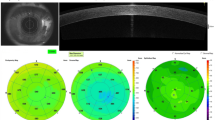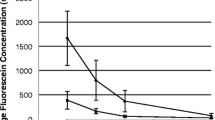Abstract
Corneal epithelial permeability and autofluorescence were measured by fluorophotometry in patients with open-angle glaucoma or ocular hypertension to quantify the epithelial function of the cornea and to evaluate its metabolic activity in 24 patients using daily timolol and 11 not using timolol. The findings were compared with those in age-matched healthy controls. Permeability values in patients using timolol were 1.9 times higher than in patients not using timolol and 2.5 times higher than in healthy controls (Mann-Whitney test P<0.001). Values for patients not using timolol did not differ from those for healthy controls (P=0.15). Corneal autofluorescence values in each patient group were higher than in healthy controls (P=0.002). Conclusions: (1) open-angle glaucoma or ocular hypertension alone does not affect corneal epithelial permeability; (2) daily instillation of timolol causes impairment of the corneal epithelial barrier; (3) open-angle glaucoma or ocular hypertension are likely to induce an increase of corneal autofluorescence.
Similar content being viewed by others
References
Burstein NL (1984) Preservative alteration of corneal permeability in humans and rabbits. Invest Ophthalmol Vis Sci 25:1453–1457
Chance B, Lieberman M (1978) Intrinsic fluorescence emission from the cornea at low temperatures: evidence of mitochondrial signals and their differing redox states in epithelial and endothelial sides. Exp Eye Res 26:111–117
Clark CV (1989) Autonomic denervation hypersensitivity in the primary glaucomas. Eye 3:349–354
Clark CV, Mapstone R (1986) Systemic autonomic neuropathy in open-angle glaucoma. Doc Ophthalmol 64:179–185
De Kruijf EJFM, Boot JP, Laterveer L, van Best JA, Ramselaar JAM, Oosterhuis JA (1987) A simple method for determination of corneal epithelial permeability in humans. Curr Eye Res 6:1327–1334
Fraunfelder FT (1989) Drugs used primarily in ophthalmology. In: Meyer SM (ed) Drug-induced ocular side effects and drug interactions. Lea & Febiger, Philadelphia, pp 476–477
Göbbels M, Spitznas M (1991) Effects of artificial tears on corneal epithelial permeability in dry eyes. Graefe's Arch Clin Exp Ophthalmol 229:345–349
Jordan K, Perry SR, McCormack PJ, Downes RN (1988) Cholinergic supersensitivity of the iris in primary open-angle glaucoma. A clinical study. Eye 2:233–237
Kaufman HE (1980) Pharmacology of ocular drugs. 1. Timolol maleate. Ophthalmology 87:164–168
Klyce SD, Bonanno JA (1988) Role of the epithelium in corneal hydration. In: Cavanagh HD (ed) The cornea: transactions of the World Congress on the Cornea 3. Raven, New York, pp 159–164
Krupin T (1988) Methods of measuring intraocular pressure. In: Loretucci K, Terry D (eds) Manual of glaucoma: diagnosis and management. Churchill Livingstone, New York, pp 16–17
Kuppens EVMJ, Stolwijk TR, van Best JA, de Keizer RJW (1992) Basal tear turnover and topical timolol in glaucoma patients and healthy controls by fluorophotometry. Invest Ophthalmol Vis Sci 33:3442–3448
Masters BR (1984) Noninvasive redox fluorometry: how light can be used to monitor alterations of corneal mitochondrial function. Curr Eye Res 3:23–26
Masters BR, Falk S, Chance B (1982) In vivo flavoprotein redox measurements of rabbit corneal normoxic transitions. Curr Eye Res 1:623–627
Nork TM, Holly FJ, Hayes J, Wentlandt T, Lamberts DW (1984) Timolol inhibits corneal epithelial wound healing in rabbits and monkeys. Arch Ophthalmol 102:1224–1228
O'Brien WJ, Decarlo JD, Stern M, Hyndiuk RA (1982) Effects of Timoptic on corneal reepithelialization. Arch Ophthalmol 100:1331–1333
Pfister RR, Burstein N (1976) The effects of ophthalmic drugs, vehicles, and preservatives on corneal epithelium: a scanning electron microscope study. Invest Ophthalmol Vis Sci 15:246–259
Ramselaar JAM, Boot JP, van Haeringen NJ, van Best JA, Oosterhuis JA (1988) Corneal epithelial permeability after instillation of ophthalmic solutions containing local anaesthetics and preservatives. Curr Eye Res 7:947–950
Stolwijk TR, van Best JA, Boot JP, Oosterhuis JA (1990) Corneal autofluorescence in diabetic and penetrating keratoplasty patients as measured by fluorophotometry. Exp Eye Res 51:403–409
Stolwijk TR, van Best JA, Oosterhuis JA, SwartW (1992) Corneal autofluorescence: an indicator of diabetic retinopathy. Invest Ophthalmol Vis Sci 33:92–97
Sweeney DF, Vannas A, Holden BA, Tervo T, Telaranta T (1985) Evidence for sympathetic neural influence on human corneal epithelial function. Acta Ophthalmol 63:215–220
Zeimer RC, Blair NP, Cunha-Vaz JG (1983) Vitreous fluorophotometry for clinical research: I. Description and evaluation of a new fluorophotometer. Arch Ophthalmol 101:1753–1756
Author information
Authors and Affiliations
Rights and permissions
About this article
Cite this article
Kuppens, E., Stolwijk, T., van Best, J. et al. Topical timolol, corneal epithelial permeability and autofluorescence in glaucoma by fluorophotometry. Graefe's Arch Clin Exp Ophthalmol 232, 215–220 (1994). https://doi.org/10.1007/BF00184008
Received:
Revised:
Accepted:
Issue Date:
DOI: https://doi.org/10.1007/BF00184008




